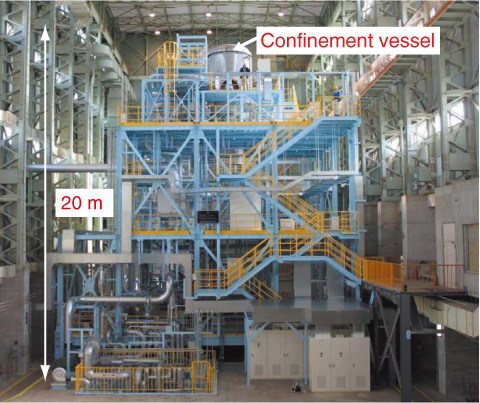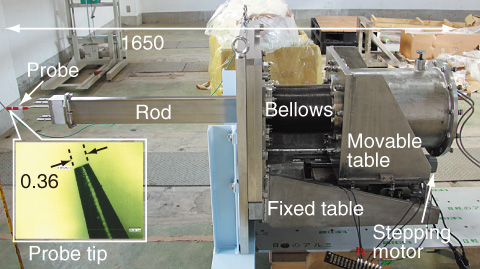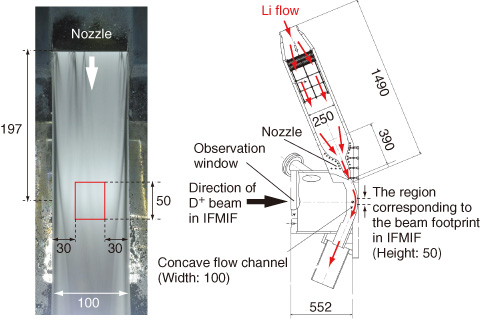
Fig.4-10 View of entire EVEDA Lithium Test Loop

Fig.4-11 Contact-type liquid level sensor (unit: mm)

Fig.4-12 Picture of Li target flow and cross-sectional view of Li flow path (unit: mm)
To realize a fusion reactor, the development of materials capable of withstanding fusion neutron irradiation is indispensable. The International Fusion Materials Irradiation Facility (IFMIF) is an intense neutron irradiation facility simulating fusion reactor conditions for the development of fusion reactor materials. In the IFMIF, neutrons are generated by the injection of deuterons into lithium (Li). The Engineering Validation and Engineering Design Activities (EVEDA) for the IFMIF are now being conducted as one of the Broader Approach activities. We are performing experiments at the EVEDA Li Test Loop (ELTL, Fig.4-10), which is a prototype of the IFMIF Li loop, with the goal of acquiring validation data toward the construction of the IFMIF.
The most important validation item is the stability of the liquid Li target, which flows at a speed of 15 m/s along a concave flow channel (25 mm in thickness) at a temperature of 250 °C with a free surface (freely deformable liquid surface). The free surface of a high-speed flow is generally unstable. Thus, it is necessary to address the very difficult problem of generating a high-speed stable flow (required flow thickness fluctuation: less than 1 mm). Although we anticipated that the centrifugal force that acts on a concave flow would suppress the fluctuation, we need to measure the actual fluctuation, and we have to develop a precise measurement device.
We developed a contact-type liquid level sensor in a smaller Li loop than the ELTL. This sensor is equipped with a sharp probe and detects contacts between the probe and the liquid as electrical signals. Analysis of the contact signals yields the properties of the free-surface waves. Some issues had to be resolved before this sensor is employed as a diagnostic tool in the ELTL. For instance, although the internal pressure of the smaller loop is equivalent to atmospheric pressure, that of the ELTL is a vacuum, and it is necessary to counter the difference of 0.1 MPa between the inner and outer pressures accordingly. Thus, we employed a strong structure and a powerful motor. On the basis of the above design, we fabricated a sensor for use in the ELTL (Fig.4-11). The performance test results show that the probe can be positioned with high precision (resolution: 0.1 mm, positioning precision: 0.01 mm) as required.
Now, we are measuring the Li target thickness. The Li target was successfully produced at a high speed of 20 m/s (Fig.4-12). The stability of the Li target is almost within the requirement.